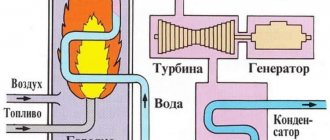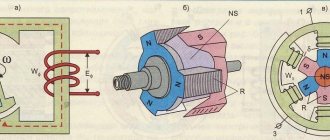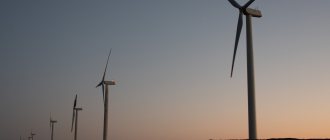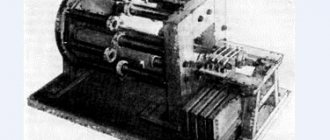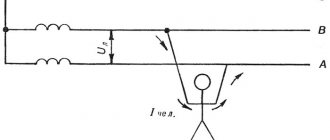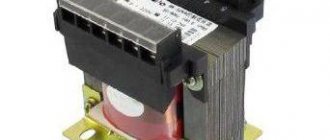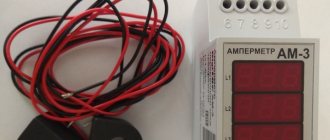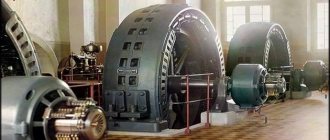An electric generator (from Latin - “producer”) is a device that generates electrical energy, that is, converts mechanical energy into electric current.
Thanks to the invention of the generator, already in the middle of the 19th century. industry and the population have a real opportunity to produce and use electricity, for example, to operate machines or illuminate houses and streets. By the way, DC electric motors are almost completely similar in design to generators. Moreover, if you rotate the armature of a DC electric motor (for example, from an electric car or other toy), it, like a generator, will begin to produce current.
Operating principle of the first generator
In 1831, the English scientist Michael Faraday discovered electromagnetic induction. The essence of this discovery was that if you rotate a conductor between the poles of a magnet, an electromagnetic field will arise in it. Such a field excites the movement of electrons, and an electric current begins to flow through the conductor. Thanks to this discovery, the creation of an electric generator and an electric motor became possible.
Electrical circuit
Requirements for a car generator
The main task of the generator is not only to generate current, but also to ensure its constant parameters, regardless of the speed of the crankshaft driving the generator. This is necessary so that the battery does not burst at low engine speeds, and at high speeds it is necessary to avoid overcharging the battery. In addition, lamps, LEDs, and electrical appliances are no less sensitive to voltage and current stability, especially in modern technologically complex cars.
The generator must not only deliver a stable current, but also be resistant to high temperatures, vibrations and moisture, and have a certain degree of dirt protection, since it is installed in the engine compartment, where operating conditions are very unstable. The design and operating principle of the alternator in almost all modern cars are identical.
How does an electric generator work?
The operation of an electric generator consists of the interaction of the stator, rotor and slip rings. The stator remains motionless when the generator is turned on. The distance between the stator and the rotor is only a few millimeters, so a very strong magnetic field arises between them, and a high-power electric current appears in the rotor winding. When voltage is applied from an external source, the stator winding turns into an electromagnet.
The rotor is connected to the shaft of a mechanical device (internal combustion engine, wind or water engine, etc.) and rotates while the generator is running. The rotor winding, as it moves, constantly crosses the magnetic field created by the stator windings, and an electric current is generated in it.
This design made it possible to get rid of large and heavy permanent magnets. Slip rings are designed to remove electrical energy from the rotor windings. They are a drum with many copper plates to which the rotor windings are connected. Graphite brushes are in contact with them on the outside, to which an electrical energy consumer is connected via wires.
Generator device
How alternating current generators were created - the most important moments in the history of creation
Producing alternating current as such has never been very difficult. In the windings of all types of machine generators (with the exception of unipolar) this type of electric current is generated, which is converted into a constant current in the collector.
Back in 1832, the inventor, whose name has not been preserved by history, created the world's first 1-phase multi-pole synchronous electric generator (EG), after which all further research in this area followed the path of improving switching devices.
It so happened that for some time this ingenious invention was not used in practice. In this regard, attempts to create other versions of equipment for generating alternating electric current until the end of the 70s. the century before last were few in number. At that time, only DC EGs existed, in the design of which two plates were installed instead of a collector.
In 1863, the Englishman G. Wilde created one of the first samples for generating alternating electric current with magnets. Instead of plates, he installed slip rings on his invention. To power the generator winding, the scientists used another additional magnetoelectric generator, which he mounted on the frame of the main one. And four years later, Wild constructed another sample of EG without a separate pathogen. Its design was based on a T-shaped armature with 1 winding:
- the main one, supplying electric current through slip rings to the external circuit;
- auxiliary, feeding the winding of electromagnets through a collector with two plates.
The new version of the generator had a significant drawback: serious losses of steel in the electric magnets due to excessively strong pulsations of the electromagnetic flux. The heating of the cores occurred so quickly that the unit could operate for no more than a few minutes.
And only the innovative proposal of the Russian scientist P. N. Yablochkov - the development of several fundamentally new units of alternating electric current for lighting at once - was a truly powerful impetus for the start of practical application. The invention was called the “Yablochkov candle”.
Around 1878, Pavel Yablochkov, who at that time was collaborating with the famous French engineering company Gramma, created an EG for powering 4, 6, 16 and 20 candles. Let's look at this innovation using the example of a 16-candle unit.
The design is based on a static ring armature with a sectional winding on 4 circuits of 4 coils each. The EG shaft with eight poles was driven by direct electric current. Each shaft had 2 coils, in which an electric current was induced with a 1⁄4 phase shift relative to each other. At the same time, the Russian scientist connected the coils in such a way that phase matching was ensured in each individual circuit. Power from each circuit was supplied to 4 Yablochkov candles. Thus, this invention was nothing more than a 2-phase synchronous EG with autonomous phases.
However, other scientists of that period did not set as their goal the creation of a multiphase system. Their goal was a machine with several circuits to solve the problem of “dividing light”, as well as its improvement and adaptation for practical use. They managed to achieve this thanks to a two-phase armature winding.
Later, P. Yablochkov proposed other EG models, incl. with reciprocating movement of the armature, as well as inductor ones, which, however, were not used in the electrical industry of that time.
And again, the same stumbling block stood in the way of development of EG: strong heating of the cores during operation. If in the case of Wild’s invention these were magnet cores, now they are armature cores. The intractable issue of reducing losses in anchor steel became key, and without its solution it was impossible to talk about the mass use of EG. Various versions of the cores of ring, rod, and drum anchors were proposed, but all of them were too massive and did not give the desired effect. And only with the beginning of the production of hatched cores in the 80s. the matter got off the ground.
Based on the above, two main directions in the development of alternating current electric power can be distinguished:
- increasing the number of armature coils in order to increase power, as before (in the middle of the 19th century) in DC units);
- reducing the specific gravity of steel in the armature to eliminate overheating of the cores and minimize losses.
At some point, EGs began to be produced, which did not have steel seats at all. Thus, in 1885, the Englishman Paddington installed an EG with 2-phase coil windings at one of the thermal stations, intended, like the Yablochkov-Gram invention, for lighting (autonomous power supply of light bulbs). With a power of 115 kW, it weighed 18 tons, was driven by a piston unit (146 rpm) and generated electric current with a frequency of 40 Hz. A steam engine was used for excitation.
So, the first alternating current electric generators suitable for industrial use were introduced approximately in the mid-80s. that same 19th century, which went down in history as the century of the most rapid scientific and technological progress. A new round in the development of modern EG began in the 90s. XX century with the beginning of the production of three-phase units with hatched cores and drum-type windings.
Modern water engine
In modern water engines, a wheel with blades is replaced by a faster water turbine (derived from the word “turbo” - “vortex”). Most often, it has a spiral casing, shaped like a snail shell. Water enters the wide end of the casing. Since the “corridor” along which it flows is narrowing all the time, its pressure increases.
Then the increased flow of water enters the concave blades of the turbine, which is located in, and rotates it. This is how the energy of the water flow is converted into mechanical work.
Standard range
Arriving at any store, you can find three basic types of electric generators. The models presented differ in the type of fuel consumed, power output and price. Let's look at this issue in more detail. So, types of electric generators.
Diesel electric generators for home
The upper power level of such units is 40 kW, with a working resource reserve of up to 40,000 hours. The products are used as an alternative or primary power source.
The advantages include efficiency in terms of fuel consumption, and stable operation without power surges. Disadvantages include high noise levels and unstable operation in sub-zero temperatures.
Gasoline
These are compact, portable devices, significantly inferior in power to the previous model. Such products provide an output voltage of up to 10 kW, operate almost silently and have a relatively low cost.
In addition, gasoline models are not designed for continuous operation. Among the advantages: ease of maintenance and low price of the product.
Gas generator
Such modifications operate on liquefied or network gas (LPG and NG, respectively). In terms of saving fuel consumption, this is the most optimal option. However, gas electric generators are more expensive than previous models.
In addition, the units do not pollute the environment with harmful emissions and are able to operate in low temperature conditions
Please note that gas equipment is explosive and precautions must be taken
It is worth noting that the listed generators are divided into synchronous and asynchronous models. Asynchronous devices do not have an armature winding, which reduces the price, but does not give the unit the ability to cope with starting loads.
Gas generator
That is, you will not be able to use electrical equipment that puts a peak load on the power grid at startup. These devices include welding machines. Asynchronous devices can withstand high power when starting electrical equipment.
But here on the rotor there are brushes that tend to burn out periodically. We recommend taking these features into account when choosing an electric generator.
Electricity from water
Today, electricity is produced by hydroelectric power plants, which use the energy of moving water.
Scheme of operation of a hydroelectric power station
A hydroelectric power plant consists of two main parts: a power unit and a dam (or dam) that stores water. The power unit contains generators that produce electric current. Their rotors rotate thanks to water turbines. This is how the energy of the water flow is converted into electricity.
Essential elements
A quartz piezoelectric exciter is often used as a resonant generator circuit. At the same time, simpler parallel resonant circuit circuits and an RC circuit (a circuit consisting of a capacitor and a resistor) can be used.
The generator may have additional circuits to change the main signal. So the 8088 processor uses only two-thirds of the clock duty cycle. This requires a clock generator. And built-in logic circuit for duty cycle conversion.
As the output clock waveform becomes more complex, a mixer, divider, or frequency multiplier can be used in the clock generator circuit. A frequency mixer generates a signal whose frequency is equal to the sum or difference of two frequencies of the input signals.
Giant hydroelectric power plants
One of the most powerful hydroelectric power stations in the world was built in China on the Yangtze River and was called the “Three Gorges”. Its concrete dam is 2309 m long and 185 m high. The total power of the station's electric generators is almost 23 MW (1 MW = 1 million W). Over the course of a year, they generate about 100 billion kWh of electricity.
Only slightly less electricity is generated by the Itaipu hydroelectric power station, located on the Parana River (on the border of Brazil and Paraguay), which has the largest dam. The height of this gigantic structure reaches 196 m, and the length is 7235 m.
Share link
Mass production
The first gasoline generators began to appear around the same time as diesel generators. At the beginning of the 20th century, some engineer, whose name remains unknown, came up with the idea of combining a diesel engine with a generator - this is how the world's first diesel generator appeared. The English company Perkins saw the potential of this device and quickly launched mass production. Following them, the now famous manufacturer Caterpillar did the same - both brands are engaged in the production of diesel generators to this day.
In the 1930s, diesel generators were used everywhere on farms and in homes remote from cities that had not yet been touched by electrification.
